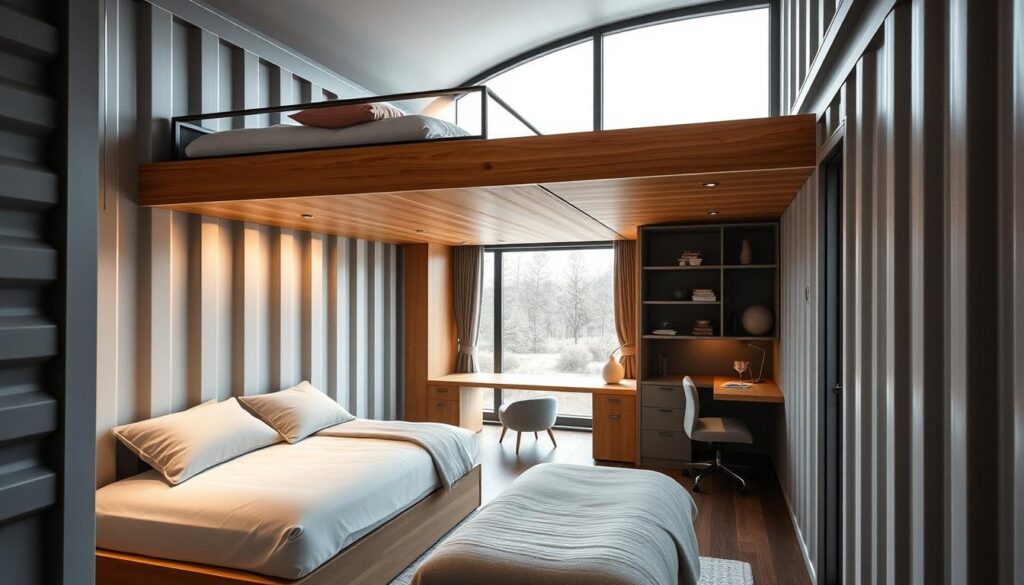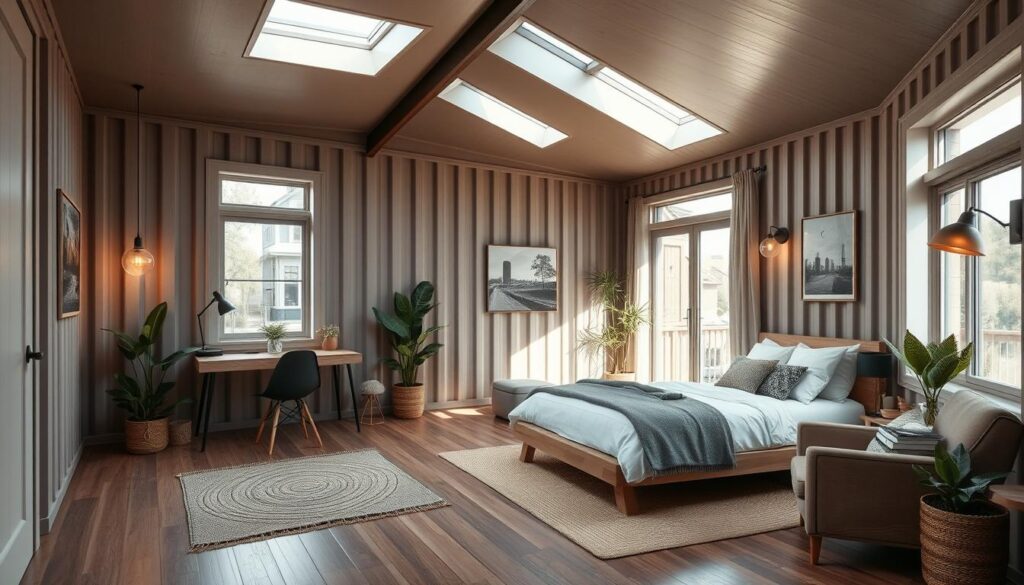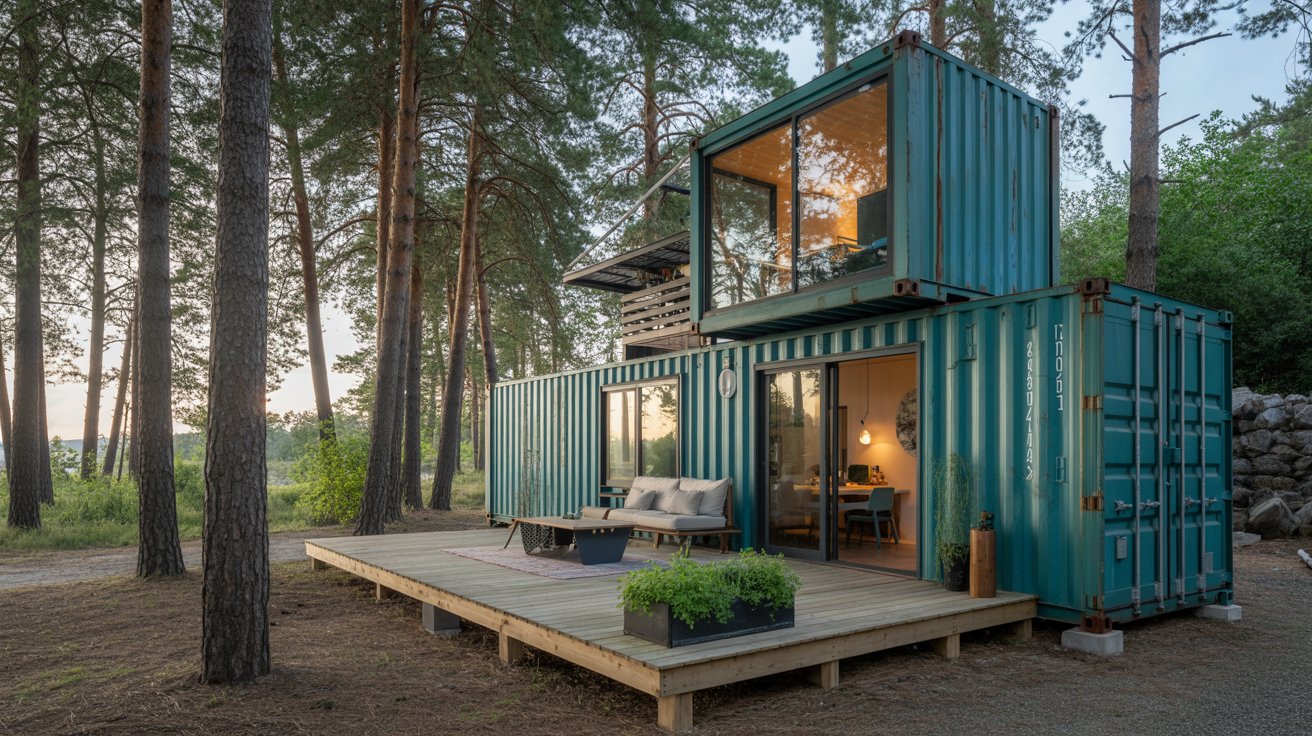Shipping container homes have gained popularity for their sustainability and versatility. One of the key challenges in designing these homes is maximizing space. A creative solution is to utilize the vertical space with loft bed ideas, creating a functional and cozy bedroom area.
By incorporating a loft, homeowners can significantly increase their living area without expanding the container’s footprint. This design not only enhances the aesthetic appeal but also improves the functionality of the space.
Successful container home designs often feature innovative loft spaces that serve as bedrooms, home offices, or storage areas. By embracing this design element, homeowners can create a more spacious and comfortable living environment.
Key Takeaways
- Loft spaces can significantly increase living areas in shipping container homes.
- Incorporating a loft can enhance the aesthetic appeal and functionality.
- Loft bed ideas can create a cozy and functional bedroom area.
- Maximizing vertical space is crucial in compact container homes.
- Successful designs often feature innovative loft spaces for various uses.
The Untapped Potential of Vertical Space in Container Homes
The key to unlocking the full potential of container homes lies in utilizing vertical space effectively. By doing so, homeowners can significantly enhance their living experience. Maximizing space in container homes is crucial for comfort and functionality.
Why Vertical Space Matters in Compact Living
In compact living environments like container homes, every square inch counts. Vertical space offers an untapped reservoir for storage, living areas, and even additional bedrooms through the use of lofts. By leveraging vertical space, residents can create a more spacious feel without expanding their footprint.
The Loft Concept: Doubling Your Usable Space
One of the most effective ways to utilize vertical space is through the incorporation of lofts. A loft can double usable space by adding an additional level for sleeping, storage, or recreational activities. This not only maximizes the existing space but also adds value to the property.
Loft space utilization tips can help homeowners make the most of their container home’s vertical dimension, turning what might be wasted space into functional living areas.
Benefits of Incorporating Loft Designs in Shipping Container Bedrooms
Incorporating loft designs in shipping container bedrooms revolutionizes the way we utilize space. By leveraging vertical space, homeowners can significantly enhance the functionality and livability of their container homes. Loft designs offer a versatile solution for creating additional living areas, storage spaces, or even separate functional zones within the limited footprint of a shipping container.
Maximizing Limited Square Footage
One of the primary benefits of loft designs is their ability to maximize limited square footage. By elevating sleeping areas or creating mezzanine levels, residents can free up valuable floor space for other uses. This is particularly beneficial in shipping container homes, where every square foot counts. Efficient use of vertical space allows for a more spacious feel, even in compact environments.
Creating Distinct Functional Zones
Loft designs enable the creation of distinct functional zones within a single room. For instance, a loft can be used for sleeping, while the lower level is reserved for living or working. This separation enhances the overall livability of the space, providing a sense of separation and privacy. Creative loft solutions can transform a single-room container into a multi-functional dwelling.
Improving Airflow and Natural Light
Well-designed lofts can also improve airflow and natural light within shipping container bedrooms. By elevating certain areas, lofts can facilitate better air circulation and allow natural light to penetrate deeper into the space. This not only enhances the ambiance but also contributes to a healthier living environment.
| Benefit | Description | Impact |
|---|---|---|
| Maximizing Space | Efficient use of vertical space | Increased livability |
| Functional Zones | Creation of separate areas | Enhanced privacy |
| Airflow and Light | Better air circulation and natural light | Healthier environment |
Planning Your Container Bedroom Loft: Key Considerations
When planning a loft for your shipping container bedroom, several key factors come into play to ensure a functional and comfortable space. The unique dimensions and structural characteristics of shipping containers require careful consideration to maximize the potential of your loft.
Assessing Container Dimensions and Structural Integrity
Before designing your loft, it’s essential to assess the dimensions and structural integrity of your shipping container. Understanding the standard sizes of shipping can help you plan a loft that fits perfectly within your container’s dimensions. Check for any damage or weaknesses in the container’s structure that could impact the loft’s stability.
| Container Size | Typical Loft Dimensions | Structural Considerations |
|---|---|---|
| 20ft Container | Loft area: 15ft x 7ft | Check for side wall damage |
| 40ft Container | Loft area: 35ft x 7ft | Ensure roof can support additional weight |
Determining Optimal Loft Height and Placement
Determining the optimal height and placement of your loft is crucial for maximizing space and ensuring comfort. Consider the height of the ceiling and the placement of windows to ensure natural light reaches both the loft and the area below. For loft space organization ideas, think about how you can use the space under the loft for storage or other functions.
Addressing Building Codes and Safety Requirements
It’s vital to comply with local building codes and safety requirements when constructing your loft. This includes ensuring proper egress in case of emergencies and using materials that meet building standards. For a small bedroom loft design, consider how you can incorporate safety features without compromising on style or functionality.
By carefully considering these factors, you can create a loft that not only maximizes your container bedroom’s space but also provides a safe, comfortable, and stylish living area.
Popular Loft Configurations for Shipping Container Bedrooms
When it comes to maximizing space in shipping container bedrooms, loft configurations play a crucial role. Loft designs not only help in optimizing the available vertical space but also add a unique aesthetic to the bedroom.

Full-Width Sleeping Lofts
Full-width sleeping lofts are an excellent way to utilize the entire width of the shipping container. This configuration allows for a spacious sleeping area, making it feel more expansive than the actual physical dimensions of the container.
Maximizing Headroom in Full Lofts
To maximize headroom, it’s essential to carefully plan the loft’s height. Ensuring there’s enough clearance between the loft floor and the ceiling is crucial for comfort and safety.
Storage Integration in Full Lofts
Incorporating storage into full-width lofts can be achieved through built-in drawers or shelves under the sleeping area, enhancing the functionality of the space.
Partial Lofts with Open Space Below
Partial lofts offer a compromise between utilizing vertical space and maintaining an open feel in the room. By not covering the entire floor area, these lofts create a sense of spaciousness while still providing additional sleeping or storage space.
Split-Level Designs for Multiple Functions
Split-level designs are particularly useful in shipping container bedrooms as they allow for multiple functions within a limited space. For instance, one level can be dedicated to sleeping, while another level can serve as a workspace or reading nook.
By incorporating loft space utilization tips and considering the specific needs of the occupants, it’s possible to create a highly functional and comfortable living space within a shipping container.
Using Loft Space in Shipping Container Bedrooms: Construction Methods
To effectively utilize loft space in container homes, understanding different construction techniques is essential. The choice of construction method significantly impacts the functionality and comfort of the loft area.
Steel Frame Loft Structures
Steel frame loft structures are a popular choice for shipping container bedrooms due to their strength and durability. Steel framing allows for flexible design options and can be easily integrated with the existing container structure. This method is particularly beneficial for creating spacious lofts without compromising the container’s integrity.
Wooden Loft Construction Techniques
Wooden loft construction is another viable option, offering a warm aesthetic that can complement the industrial feel of shipping containers. Wooden structures can be more cost-effective and easier to work with for DIY projects. However, they require proper treatment to ensure durability and resistance to pests and moisture.
Modular and Prefabricated Loft Solutions
Modular and prefabricated loft solutions are gaining popularity for their convenience and efficiency. These systems are designed to be easily installed within the container, minimizing on-site labor and reducing construction time. Prefabricated lofts can offer a high level of quality control and can be customized to fit specific container dimensions.
| Construction Method | Advantages | Considerations |
|---|---|---|
| Steel Frame | Strong, durable, flexible design options | Higher cost, requires professional installation |
| Wooden Construction | Aesthetic appeal, cost-effective, DIY-friendly | Requires treatment for durability, potential for pest damage |
| Modular/Prefabricated | Convenient, efficient, high-quality control | Higher upfront cost, limited customization |
Smart Access Solutions for Container Lofts
Smart access solutions are crucial for maximizing the potential of container lofts. Effective access to these elevated spaces not only enhances functionality but also ensures safety and convenience.
Space-Saving Staircase Designs
When it comes to accessing container lofts, traditional staircases might not always be feasible due to space constraints. Space-saving staircase designs offer a practical solution. These designs are engineered to be compact without compromising on comfort or safety.
Alternating Tread Stairs
Alternating tread stairs are a type of staircase that saves space by having treads that alternate between left and right. This design allows for a steeper ascent, making it ideal for container homes where space is limited.
Spiral and Compact Staircases
Spiral staircases and other compact designs are another option for accessing lofts. These staircases are not only functional but also add a unique architectural element to the interior of the container home.
Ladder Options for Minimal Footprints
For container lofts where a staircase might still be too bulky, ladders offer a minimalist access solution. Ladders can be fixed or retractable, providing a space-efficient way to reach the loft area.
Innovative Climbing Solutions for Tight Spaces
In some cases, even ladders might not be suitable. This is where innovative climbing solutions come into play. These can include custom-designed climbing structures or integrated storage that doubles as steps.
| Access Solution | Space Efficiency | Safety |
|---|---|---|
| Alternating Tread Stairs | High | Medium |
| Spiral Staircases | High | High |
| Ladders | Very High | Medium |
| Innovative Climbing Solutions | Very High | High |
Loft Space Organization Ideas for Container Bedrooms
The versatility of loft spaces in container homes offers numerous opportunities for creative organization. Effective loft space utilization can transform a compact container bedroom into a functional and comfortable living area.
Under-Loft Storage Strategies
One of the most effective ways to organize loft space is by utilizing the area under the loft for storage. This can be achieved by installing drawers, shelves, or cabinets that fit snugly under the loft structure. For instance, container house designs often incorporate under-loft storage to maximize space.
- Use under-loft space for storing seasonal items or infrequently used belongings.
- Install pull-out drawers or shelves for easy access to stored items.
- Consider using stackable containers or bins to optimize storage capacity.
Built-In Solutions for Loft Areas
Built-in solutions can significantly enhance the functionality of loft areas. By incorporating built-in furniture and storage, you can create a clutter-free and organized space. As noted by interior design experts, “Built-in furniture is not just about saving space; it’s about creating a seamless and integrated look that enhances the overall aesthetic of the room.”
“Built-in furniture is not just about saving space; it’s about creating a seamless and integrated look that enhances the overall aesthetic of the room.”
| Built-In Solution | Benefits |
|---|---|
| Built-In Shelves | Provides additional storage and display space |
| Built-In Desks | Creates a dedicated workspace without taking up extra floor space |
| Built-In Wardrobes | Maximizes storage for clothing and accessories |
Multi-Functional Furniture for Dual-Purpose Spaces
Multi-functional furniture is key to optimizing loft spaces. Pieces that serve more than one purpose can help reduce clutter and improve the overall functionality of the area. For example, a storage bed or a desk with built-in storage can be invaluable in a small loft space.
Some examples of multi-functional furniture include:
- Murphy beds with built-in desks or storage
- Ottomans with storage compartments
- Coffee tables with lift-top storage
By incorporating these strategies, you can create a well-organized and functional loft space in your container bedroom, making the most of the available area.
Designing and Decorating Your Container Loft Bedroom
Elevate your container home living experience by designing a loft bedroom that is both stylish and functional. Creating a serene and inviting atmosphere in your container loft bedroom involves thoughtful consideration of various design elements.
“The way we design and decorate our living spaces significantly impacts our mood and overall well-being,” says interior design expert, Jane Smith. This is particularly true for compact spaces like container loft bedrooms, where every design decision counts.
Color Schemes to Enhance Spatial Perception
Choosing the right color scheme is crucial in making your loft bedroom feel spacious and welcoming. Lighter colors on walls and ceilings can create an illusion of more space, while darker shades can add coziness.
Consider a palette that includes soft whites, creamy tones, and gentle pastels to enhance spatial perception. Monochromatic color schemes can also be effective in creating a sense of continuity and flow.

Lighting Solutions for Loft Spaces
Lighting plays a vital role in setting the ambiance of your loft bedroom. A combination of natural and artificial lighting can make the space feel more inviting.
To maximize natural light, consider installing skylights or larger windows. For artificial lighting, use a mix of overhead lighting, table lamps, and string lights to create a layered effect. LED strip lighting can be particularly effective in highlighting architectural features.
Textiles and Materials for Comfort and Style
The choice of textiles and materials can significantly impact the comfort and aesthetic appeal of your loft bedroom. Opt for soft, breathable fabrics for bedding and curtains.
Incorporating natural materials like wood and bamboo can add warmth to the space. Consider using reclaimed wood for furniture or accent walls to introduce character and texture.
“The best rooms have something to say about the people who live in them.” – Jayne Clark
, your container loft bedroom should reflect your personality and style, making it a true sanctuary.
Cost Considerations for Container Bedroom Loft Projects
Maximizing space in container homes often involves loft constructions, but the costs can be a significant consideration. When planning such a project, it’s essential to understand the various factors that influence the overall expense.
Budget Breakdown: Materials and Labor
The total cost of a container bedroom loft project can be broadly categorized into materials and labor. Materials include the structural elements like steel or wood for the loft, safety features such as railings, and finishes like flooring and wall treatments. Labor costs, on the other hand, depend on whether you opt for a DIY approach or hire professionals.
Material Costs: The choice between steel and wood can significantly impact your budget. Steel is generally more expensive but offers greater durability, while wood can be more cost-effective but may require more maintenance.
DIY vs. Professional Installation Comparison
Deciding between a DIY installation and hiring professionals is a crucial aspect of your project. While DIY can save on labor costs, it requires a significant amount of time and expertise. Professional installation, though more expensive, ensures that the job is done correctly and safely.
| Aspect | DIY Installation | Professional Installation |
|---|---|---|
| Cost | Lower labor costs | Higher labor costs |
| Time | Significant time investment | Quicker completion |
| Safety | Risk of errors | Ensured safety standards |
Long-Term Value and Return on Investment
Investing in a loft for your shipping container bedroom not only enhances your living space but can also increase the value of your property. A well-designed loft can make your home more attractive to potential buyers if you decide to sell in the future.
Long-term benefits include improved functionality and potentially higher resale value. It’s essential to weigh these against the initial costs to understand the true value of your investment.
Conclusion: Elevating Your Container Living Experience
Using loft space in shipping container bedrooms is an effective way to maximize living areas. By incorporating loft designs, homeowners can double their usable space, creating distinct functional zones and improving airflow and natural light.
Effective loft space organization ideas are crucial to making the most of this additional space. From under-loft storage strategies to built-in solutions and multi-functional furniture, there are numerous ways to optimize loft areas.
By carefully planning and designing loft spaces, individuals can elevate their container living experience, creating a more comfortable, functional, and stylish home. Whether you’re looking to enhance your existing container home or planning a new project, considering loft space can significantly impact your living experience.

